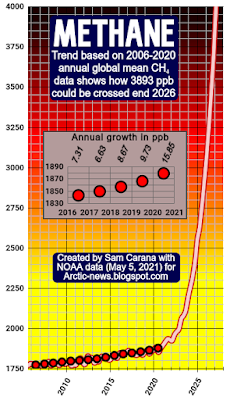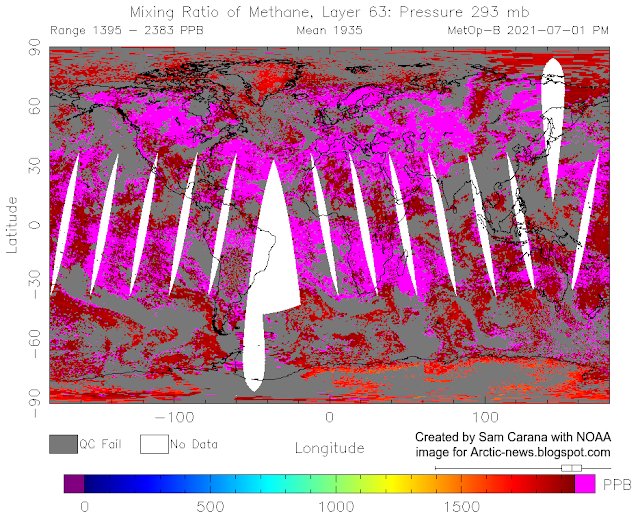On July 1, 2021 pm, the MetOp-1 satellite recorded a mean methane level of 1935 ppb at 293 mb.
 |
| [ from earlier post ] |
This mean methane level translates into 387 ppm CO₂e at a 1-year Global Warming Potential (GWP) of 200.
This GWP is appropriate in the light of the danger of a huge burst of methane erupting from the seafloor of the Arctic Ocean, which would, due to the abrupt nature of such an eruption, make its impact felt instantaneously.
Carbon dioxide on July 1, 2021, was 418.33 ppm, as illustrated by the NOAA image below.
A 5 Gt seafloor methane burst would double methane in the atmosphere and could instantly raise the CO₂e level to 1200 ppm and trigger the clouds feedback (top right panel of above chart).
Even without such a huge eruption of methane from the seafloor, there are further pollutants than just carbon dioxide and methane, such as nitrous oxide, nitrogen oxides, CFCs, carbon monoxide, black carbon, brown carbon and water vapor, and they haven't yet been included in the above CO₂e total. The levels of all these pollutants could rise strongly in a matter of years and feedbacks could start kicking in with much greater ferocity, while the resulting extreme weather events would cause sulfate cooling to end, resulting in an 18.43°C temperature rise that could be reached as early as 2026 (left panel of above chart).
Carbon dioxide on July 1, 2021, was 418.33 ppm, as illustrated by the NOAA image below.
Together, this CO₂e level of methane and this carbon dioxide level add up to 805.33 ppm CO₂e, which is 394.67 ppm CO₂e away from the 1200 ppm clouds tipping point which on its own could increase the temperature rise by a further 8°C, as discussed in an earlier post.
This 394.67 ppm CO₂e, again at a 1-year GWP of 200, translates into 1973 ppb of methane. In other words, a methane burst of 1973 ppb or about 5 Gt of methane would suffice to trigger the clouds feedback, adding a further 8°C to the temperature rise, as depicted in the image below.
A 5 Gt seafloor methane burst would double methane in the atmosphere and could instantly raise the CO₂e level to 1200 ppm and trigger the clouds feedback (top right panel of above chart).
 |
| [ from earlier post ] |
To further illustrate this, the image on the right shows a trend that is based on NOAA 2006-2020 annual global mean methane data and that points at a mean of 3893 ppb getting crossed by the end of 2026, more than twice the 1935 ppb mean methane level of the image at the top.
Such a high mean methane level by 2026 cannot be ruled out, given the rapid recent growth in mean annual methane levels (15.85 ppb in 2020, see inset on image). And, as said, there are further pollutants, in addition to methane, and additional feedbacks to take into account.
As discussed in an earlier post, humans will likely go extinct with a 3°C rise, while a 5°C rise will likely end most life on Earth.
The temperature rise from pre-industrial to 2020 may well be as large as 2.28°C, as the bottom figure in the bar on the left of above chart shows and as discussed in an earlier post.
Will the IPCC get its act together?
Meanwhile, the IPCC plans to release its next report, the Working Group I contribution to the Sixth Assessment Report (AR6), on August 9, 2021, in the lead up to the COP 26 UN Climate Change Conference, from October 31 to November 12, 2021 in Glasgow, UK. Given their track record, the IPCC and politicians may be reluctant to even consider the information in this post, but it clearly is high time for the IPCC to get its act together.
The temperature rise from pre-industrial to 2020 may well be as large as 2.28°C, as the bottom figure in the bar on the left of above chart shows and as discussed in an earlier post.
Will the IPCC get its act together?
Meanwhile, the IPCC plans to release its next report, the Working Group I contribution to the Sixth Assessment Report (AR6), on August 9, 2021, in the lead up to the COP 26 UN Climate Change Conference, from October 31 to November 12, 2021 in Glasgow, UK. Given their track record, the IPCC and politicians may be reluctant to even consider the information in this post, but it clearly is high time for the IPCC to get its act together.
The IPCC said, in SR15_FAQ, that the "global temperature is currently rising by 0.2°C (±0.1°C) per decade, human-induced warming reached 1°C above pre-industrial levels around 2017 and, if this pace of warming continues, would reach 1.5°C around 2040."
Sam Carana: "The temperature rise for the most recent decade (2011-2020) is 0.41°C (NASA data) and the rise from pre-industrial may be 2.28°C, so if this pace continued, 3.11°C could be reached by 2040 and humans will likely go extinct with a 3°C rise. Worse, the rise is accelerating and a rise of as much as 18.43°C could occur by 2026."
Potential temperature rise from pre-industrial to 2026
We face the threat of a potential temperature rise from pre-industrial to 2026 of 18.43°C and the eventual disappearance of all life from Earth, as illustrated by the image below. NASA data shows a 1920-2020 temperature rise of 1.29°C. To calculate the rise from pre-industrial, 0.29°C is added for the 3480 BC-1520 rise, 0.2°C for 1520-1750 and 0.3°C for 1750-1920, while 0.1°C is added to reflect higher polar anomalies and 0.1°C for air temperatures, adding up to a rise of 2.28°C from pre-industrial. A temperature rise of a further 16.15°C could happen by 2026, adding up to a total potential temperature rise of 18.43°C from pre-industrial to 2026. Most species will likely go extinct with a 5°C rise, but humans will likely go extinct with a 3°C rise and eventually, all life would disappear from Earth, as discussed in an earlier post.
In the video below, Guy McPherson comments on the IPCC.
EPA could and should act now
In the US, Joe Biden could simply instruct the EPA to enforce tighter standards. The US supreme court ruled on June 26, 2006, that the EPA has the authority to set standards for greenhouse gas emissions. In 2009, the EPA confirmed that greenhouse gas emissions are pollutants that endanger public health and welfare through their impacts on climate change and admitted that the EPA has the responsibility and the duty to regulate greenhouse gas emissions, and it took until August 3, 2015, for the EPA to issue the Clean Power Plan, giving states a number of choices how to reach set targets for CO₂ emissions. In the light of recent scientific findings and in line with the Paris Agreement, adopted on 12 December 2015, it now makes sense for the EPA to strengthen these targets and enforce this without delay.
Conclusion
The situation is clearly dire and calls for more immediate, more comprehensive and more effective action, as described in the Climate Plan.
Links
• Climate Plan
https://arctic-news.blogspot.com/p/climateplan.html
• Could temperatures keep rising?
• Confirm Methane's Importance
https://arctic-news.blogspot.com/2021/03/confirm-methanes-importance.html
• When Will We Die?
https://arctic-news.blogspot.com/2019/06/when-will-we-die.html
• Overshoot or Omnicide?
https://arctic-news.blogspot.com/2021/03/overshoot-or-omnicide.html
• NASA, Goddard Institute for Space Studies (GISS)
• NASA, Goddard Institute for Space Studies (GISS)
https://data.giss.nasa.gov/gistemp
• IPCC: Frequently Asked Questions, Special Report on Global Warming of 1.5°C
https://www.ipcc.ch/site/assets/uploads/sites/2/2018/12/SR15_FAQ_Low_Res.pdf
• Possible climate transitions from breakup of stratocumulus decks under greenhouse warming - by Tapio Schneider et al.
https://www.nature.com/articles/s41561-019-0310-1
• Most Important Message Ever
https://arctic-news.blogspot.com/2019/07/most-important-message-ever.html
• Heatwaves and the danger of the Arctic Ocean heating up
• Science Update: Continued IPCC Conservatism and Lies - by Guy McPherson
• IPCC: Frequently Asked Questions, Special Report on Global Warming of 1.5°C
https://www.ipcc.ch/site/assets/uploads/sites/2/2018/12/SR15_FAQ_Low_Res.pdf
• Possible climate transitions from breakup of stratocumulus decks under greenhouse warming - by Tapio Schneider et al.
https://www.nature.com/articles/s41561-019-0310-1
• Most Important Message Ever
https://arctic-news.blogspot.com/2019/07/most-important-message-ever.html
• Heatwaves and the danger of the Arctic Ocean heating up





Comments
Post a Comment